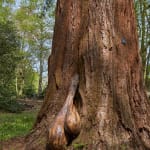Henrique Oliveira
51 1/8 x 23 5/8 x 13 3/4 in.
Further images
Two pendulous seed pods constructed from an assemblage of tree bark and wood layered around a central form, tuck into the crevices of the natural habitat. The surface is split and rough, with edges left deliberately splintered, bound together by luscious pooling resinous material that catches the light. This technique of xilempasto refers to the wood protection palisades, fencing and boarding typical of Brazilian construction sites which the artist salvages to use in his monumental installations and paintings, where he retains their found twists, curves, bends and splits.
In the form of paintings, sculptures or installations, the hybrid art of Henrique Oliveira evokes both the urban and the natural, the organic and the structural, as well as art and science, through compositions in which the unexpected generates a universe tinted with the fantastic. Using both natural and manmade materials the artist does not use the term eco in relation to his works, but states: “As the virtual world increasingly becomes part of our everyday life, the more we will search for material compensation”.
This is a unique work that has a natural patina and can be positioned in a variety of contexts.
Oliveira was the winner of the third edition of the CNI SESI Marcantonio Vilaça Award (Brazil), in 2009. He had solo exhibitions in important spaces including Centro Cultural São Paulo, SP, Brazil (2018) and Gifu Museum of Fine Arts, Gifu, Japan (2018); Van de Weghe Gallery, New York, USA (2017); Anexo Millan, São Paulo, Brazil (2016); Galerie Georges-Phillipe & Nathalie Vallois, Paris, France (2015); Museu de Arte Contemporânea da Universidade de São Paulo, Brazil, and Arthur Ross Gallery – University of Pennsylvania, Philadelphia, USA (2014); Palais de Tokyo, Paris, France (2013); and Boulder Museum of Contemporary Art, Boulder, USA (2011).
Exhibitions
7th Edition (2023), Contemporary Sculpture Fulmer, Fulmer, UK (Guest Curator: Jenn Ellis)









